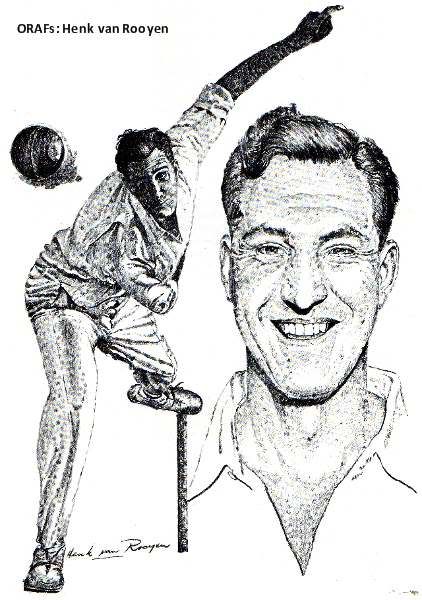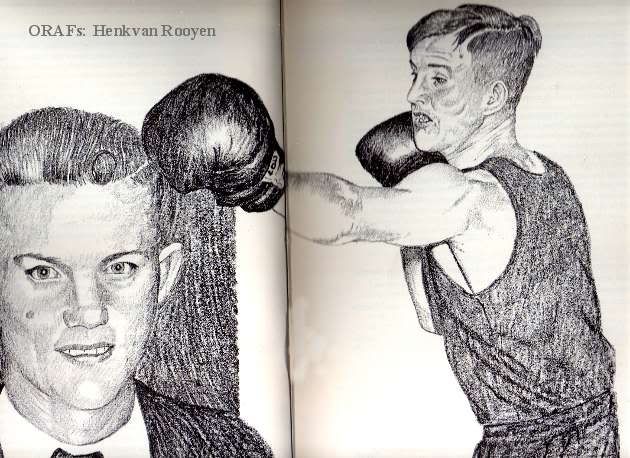Kenneth Colin Bland
In THE 1960s a tall, lithely built Rhodesian revolutionised what had always been accepted as the dullest aspect of the sport of cricket — the art of fielding.
The man was K. C. (Colin) Bland, who, with singular dedication to long hours of practice, set the cricket world alight with his spectacular efforts in the field and placed a new emphasis on an aspect of the game that had previously attracted little attention.
As a young man, Bland, believing that he was primarily a batsman, felt he could still make a material contribution to a team effort by fielding well even if he turned in a low batting score.
That was the beginning of an arduous fitness and training programme to which Bland stuck throughout his playing days. Following the Canadian Air Force 5BX fitness programme, Bland got himself into peak condition and stayed there. Encouraged by his father, he embarked on a fielding training course that involved long hours of picking up the ball on the run and throwing down stumps set up in front of a hockey goal.
The hard work paid off. With his reflexes honed razor-sharp, Bland was able to perform near miracles in the field. He developed his skill to such a degree that the run-out became a real weapon in the Springbok teams for which he played. His pick-up and return-throw in one fluid movement from any angle became legendary and by 1964 he was generally acknowledged as the finest fielder in the world.
In 1965 Bland toured England with Pieter van der Merwe's Springboks and in the first Test at Lord's he stunned the crowds with a brilliant pick- up and throw from square leg to dismiss Ken Barrington. Jim Parks suffered a similar fate in the same Test when Bland threw down his stumps. The rangy Rhodesian became a celebrity and a great draw card. For the first time, people were flocking to cricket matches to watch a man field.
Bland's performances on that tour prompted Alan Ross of the London Observer to write: "He is a handsome attacking batsman, orthodox in defence and a powerful driver with a taste for hitting unexpected straight sixes without apparent effort "But it is as a fielder that he is unique, bridging the wide gap between accomplishment and art"
Of that first Test at Lord's, Crawford White of the Daily Express wrote: "There was majestic eagle-like ferocity and grace in the way Bland swooped to throw out Barrington."
The victim, Barrington, had this to say: "I knew Colin was great but he's greater than I thought A batsman always knows where Bland is. He has to know, to live!"
Bland was not only an accomplished batsman and a brilliant fielder; he also had a sensible and analytical approach to the game. He was always thinking about how he could improve his own performance and of ways to get the other side out. An ideal example of Bland's scheming was a match against Mike Smith's touring MCC side at the Police Ground in Salisbury.
Mike Brearley of Middlesex was batting, Bland was in his happy hunting ground at cover and his Old Georgians club-mate, Vernon Dickenson, was at mid-off. Brearley consistently pushed the ball towards mid-off; Bland would come cantering in, stoop as though to collect the ball and let it go through to Dickenson while the batsmen took an easy single.
This occurred several times but in one over Dickenson suddenly stood about fifteen metres deeper. Brearley played to mid-off, saw Dickenson was deeper and went off for a single. But this time Bland came in like an express train and threw down Brearley's stumps in one movement with the unfortunate batsman well out of his ground. The great Ted Dexter was one of Bland's victims in similar fashion when the Cavaliers played at Salisbury, and there have been countless others in all classes of cricket.
Kenneth Colin Bland was born at Bulawayo on-5 April 1938, a third generation Rhodesian of Scottish descent. His talent at cricket was quick to manifest itself when he scored his first century at the age of ten for Baines Junior School. He played for Rhodesian and South African Schools in 1956 and 1957 and made his first-class debut as a nervous eighteen-year-old Milton schoolboy honoured by selection for Rhodesia against Peter May's 1956-57 MCC touring side.
His debut was exemplary and he top-scored in both innings with 19 and 38 —and that was against an attack which included the great fast bowler Frank Tyson.
From that auspicious beginning it became clear that Bland had a great future in cricket. In 1960 he captained South African Universities to a victory in two days over Western Province and in the process hit 124 out of the Universities' total of 347-5.
After a successful tour of England with the young invitation South African Fezelea's team in 1961, Bland was selected to play for South Africa against the touring New Zealand team later that year. It was not a spectacular Test debut for Bland, though his performances could hardly be classed as failures. He scored a total of 205 runs with a top score of 42 but the talent was obviously there and he gained selection for the South African team to tour Australia in 1963 and 1964.
He was not selected for the first Test of the tour as he was a little slow in finding form, but after the first Test there was no stopping him. In six innings he scored 367 runs with an average of over 60 including a magnificent 126 in the fifth and final Test. His average of 61,16 was second only to Eddie Barlow (75) and was better than batting genius Graeme Pollock, who finished his first tour with an average of 57.
Bland played in all three Tests against New Zealand and totalled 207 runs at the excellent average of 69. As a batsman he was blossoming and the following1964-65 season was to be his best when he played eight Tests against England — five in South Africa and three in England, by which time his fielding prowess was legendary.
In the second Test against Mike Smith's England side at the Wanderers in Johannesburg, Bland passed the milestone of 1 000 runs in Test cricket. He hit a magnificent undefeated 144 to take his Test total to 1 046, scored from 14 Test matches.
Bland passed another milestone in the fifth Test at Port Elizabeth when his innings of 48 took him beyond Jackie McGlew's long-standing record for first class runs scored in a South African season. It did not stop there.
By March 1965,Bland had become the first man to score 1 000 first-class runs in a South African season. He did it by hitting 62 for Rhodesia in a match against English County champions Worcestershire at Salisbury. The innings took his aggregate to 1048 runs, easily beating McGlew's previous record of 953.
It was a highly satisfying season for the Rhodesian. He had also topped the South African Test averages with 572 runs at 71,5 including a century and four half-centuries.
After the 1965 tour of England, where he so impressed as a fielder, Bland was honoured by an invitation to play for the World XI in two matches against England in September. By then he had scored 1 351 runs in 17 Tests. But it was still his fielding prowess that made Bland a cricket celebrity, someone for schoolboys to emulate.
He was extremely popular in England and drew large crowds to exhibitions of his fielding, thereby publicising a facet of cricket normally accepted as being a very ordinary and unexciting part of the game.
Ian Woolridge of the London Daily Moil commented on Bland's run-out of Barrington: "It was an electrifying moment of fielding. It is the story, not only of the throw that turned a Test but of a man who can do for fielding what Bradman did for batting." This was not isolated praise. Bland was honoured by being named as one of Wisden's Five Cricketers of the Year for 1965, and in November of that year he was awarded the John Hopley Memorial Trophy as Rhodesia's Sportsman of the Year.
The 1966 South African season was a turning-point for Bland. He was selected for the Springbok team to play the five Test series at home against Bobby Simpson's Australians but he injured his right knee on the final day of the first Test at the Wanderers at Johannesburg.
The accident happened when Bland, in typical fashion, was putting in maximum effort to stop a ball reaching the boundary. He collided with the picket fence and that injury effectively ended his Test career.
In September 1966 he had been selected for the World XI and hit 132 in their first match against Sussex. But his knee had shown signs of weakening and he played little part in the World XI's remaining matches.
Eventually he had a cartilage removed in an operation at Salisbury in January 1967. He made a good recovery and was back playing in league cricket less than a month later.
He continued to play for Rhodesia in Currie Cup and in August 1967 was appointed national cricket coach. He also captained Rhodesia in thirteen matches, winning four, losing four and drawing five, and hit his highest first-class score of 197 against Border that season.
In 1968 he received the almost customary invitation to play for the World XI in England and he duly set off in August only to be prevented from entering Britain because of his Rhodesian passport. It was a great disappointment for Bland and for British cricket fans who treasured memories of the Bland style of fielding which had made such an impact three years before.
Thereafter, his career wound down rapidly. At the end of 1969 he left Rhodesia to live in Port Elizabeth and played Currie Cup for Eastern Province, but a year later he retired from the first-class game.
In 1971 Bland accepted the post of cricket and hockey coach at Free State University and Grey College in Bloemfontein. A year later, while running a sports goods shop in the city, he was honoured with life membership of the MCC. By 1973 Bland was persuaded to return to cricket as captain of Free State in the Currie Cup B section before finally giving in at the end of the season.
An extraordinary sportsman who, in his earlier career had played hockey for both Rhodesia and Eastern Province whilst at university, Bland then turned to squash coaching.
Cricket owes a great debt to Colin Bland. He gave entertainment and joy to thousands and left a standard to which all those who profess to be competent in the field should wish to aspire.
CAREER FIGURES
Test Series
1961-62 Vs. New Zealand
Tests: 5
Runs: 205
100s: Nil
Average: 22,77
1963-64 in Australia
Tests: 4
Runs: 367
100s: 1
Average: 61,16:
1963-64 in New Zealand
Tests: 3
Runs: 207
100s: Nil
Average: 69,00
1964-65 Vs. England
Tests: 5
Runs: 572
100s: 1
Average: 71,50
In 1965 in England
Tests: 3
Runs: 286
100s: 1
Average: 47,66
1966-67 Vs. Australia
Tests: 1
Runs: 32
100s: Nil
Average: 16,00
Total
Tests: 21
Runs: 1 699
100s: 3
Average: 49,08
For Rhodesia 1956-68
Matches: 55
Runs: 87
100s: 10
Highest Score: 197
Average: 49,08
Centuries: 4
Half Centuries: 13
Catches: 22
Overall career runs: about 7 000 at an average of about 40.
- McDERMOTT.
To view the Blog Home Page - Please Click Here.
(Please visit our previous posts and archives)
Labels: cricket, Kenneth Colin Bland, Rhodeasia, springboks




